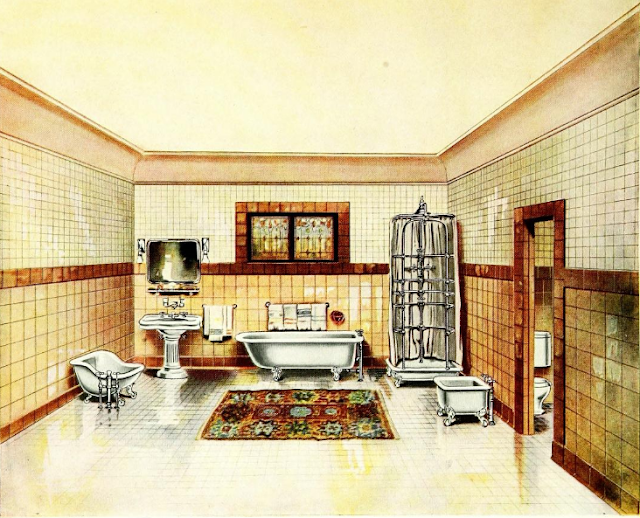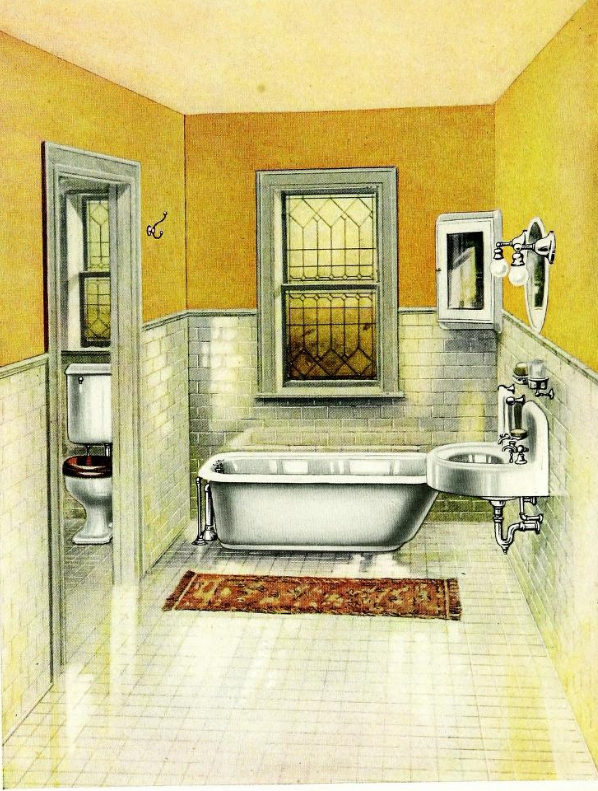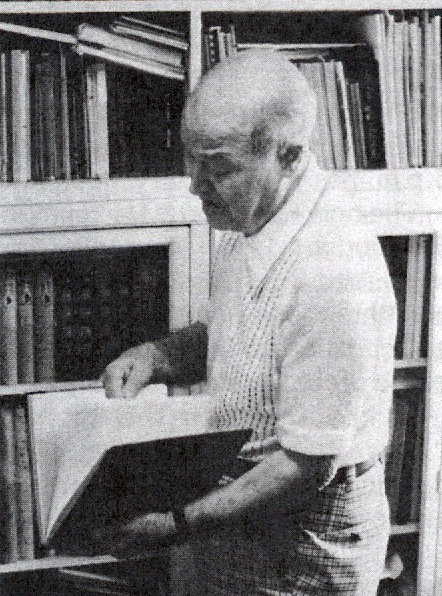The inventor, Tike Miller (J.H. Miller), did not set out to create one of the most unique vending machines ever constructed. He merely wanted to replace a broken piece for his Holiday Nativity set. When he went to the department stores, they only sold complete sets. Seeing the need, he and his wife started making plaster Nativity pieces in their basement. Soon, he had a factory, making dozens of plaster figurines that he sold in those same department stores.
In later years, Miller crafted additional lines of figurines. They made a line of Space Invaders, Jungle Animals, Holiday Specialties, and his famous Dinosaurs. The difference in these figures was that they were made with waxy plastic instead of plaster. It is thought that this is where Miller first started his experiments with plastic and his new plastic injection process. Using his plastic injection molding machines, Tike made hundreds of wax/plastic dinosaurs in his Quincy, Illinois, factory.
 |
| 1965 |
In the late 1950s, Tike Miller sold the rights to his idea of a souvenir-making machine to Automatic Retailers of America Inc. (ARA). For the next few years, he worked with ARA to develop a new vending machine that could make a wax souvenir for anyone with a quarter. A new division of ARA was born, and the term Mold-A-Rama entered the public vernacular.
Debuting at the 1962 Seattle World's Fair, the bubble-topped machines created waxy, plastic models of the Fair's showcase building, the Space Needle, a monorail, a Buddha, a 3D sculpture of the Fair's logo, and other fun designs. At 50¢ each ($5 today), the souvenirs weren't cheap, but the experience of watching the statue created before your eyes must have convinced fairgoers they were seeing the future of manufacturing.
The William A. Jones Company was founded on April 22, 1971, when Jones purchased his first Mold-A-Rama machines from Roy Ward in Chicago.
Roy was an employee of the original Mold-A-Rama Inc. and purchased several machines and two operating locations, Brookfield Zoo & The Museum of Science and Industry, both in Chicagoland, from ARA. When they decided to dissolve the Mold-A-Rama division of ARA, he operated for only a few years and then decided to sell his machines and retire.
Jones was a Michigan State Graduate working as a supervising accountant at Interstate United, a vending & food service Company much like ARA. After a particularly long day, Bill told soon-to-be retiring coworker Doris Ward, "Why don't you have your husband sell me his business so I can get out of this rat race the same time you do." She replied, "Roy and I were discussing finding a buyer last night." A year and a half later, after working with Roy on weekends, Bill Jones acquired all the Mold-A-Rama machines in the Chicago area.
The production of the Mold-A-Rama machines ended in the mid-1960s.
By 1971, the original Mold-A-Rama Inc. had dissolved entirely, and ARA grew. Today, that company is known as Aramark Food Company (worth $10.5 Billion today). A handful of small businessmen saw the potential in Mold-A-Rama machines and kept them out and running. One of them was Paul Nathanson, an operator out of Minnesota. Paul and Bill soon began working with each other, sharing purchases of custom-made parts. They loaned each other materials and helped each other when needed. Paul Nathanson was one of the original franchisees of Mold-A-Rama and had several working accounts and many more machines than William. But in the early eighties, Paul decided he wanted to call it quits, and William bought him out and became the Midwest's biggest operator of Mold-A-Rama machines.
sidebar
Some years after Mold-A-Rama Inc. was dissolved by ARA, Tike Miller was back to wearing his inventor hat. Recognizing Aluminum's value and popularity, his newest creation reclaimed this precious metal and then paid the recycler cash for the aluminum cans they had deposited. Years ahead of its time, the “Golden Goat,” as it was called, could fit in any supermarket parking space, taking up only a couple of parking spaces. Tike Miller was truly ahead of his time.
William A. Jones Co. had expanded from just the Chicago area to four states, and William brought in his sons Paul and Bill Jr. to help run the business. The Mold-A-Rama machines just keep getting older and older but are a favorite for visitors at major attractions nationwide.
At one time in the early 1970s, Mold-A-Rama machines were ubiquitous in museums, zoos, and other attractions all over the US. They were injection molding machines, and the plexiglass bubble allowed you to see a tiny part of the process — basically, the two halves of the mold coming together. Then, when they separated, you saw your molded statue in all its shiny plastic glory as a spatula-like device scraped the statue off the base underneath, dumping it into a slot for your convenient retrieval. There were dozens of designs in various colors — some specific to the place — like Disney theme parks and Sea World — while others were more generic.
There were animals, vehicles (including the Space Shuttle), things like Santa, Christmas trees, and even the Houston Astrodome. The statuettes grow frail as they age and become more susceptible to catastrophic breakage after a couple of decades.
The Mold-A-Rama figures were a delightful treat from childhood. People remember the excitement fondly at feeding quarters into the machine, waiting while the loud rumbling and hissing of the pneumatics involved, and finally, seeing the molded creation revealed before it was unceremoniously dumped into the retrieval slot. It was still quite warm at this stage, and the instructions on the machine cautioned the new owner to hold the figure upside-down by the base until it had cooled to prevent any still-liquid plastic from spilling out through the two holes in the base. The hot plastic smell was unique and highly memorable even to this day.
In 2011, Jones Co. changed the company name to Mold-A-Rama and incorporated. Now, the largest operator of Mold-A-Rama machines in the Midwest is once again known as . . . Mold-A-Rama Incorporated.
Bill Jr. died in 2014. In 2015, William A Jones decided to step back into semi-retirement.
Compiled by Dr. Neil Gale, Ph.D.
2022 MOLD-A-RAMA MACHINE LOCATIONS
Mold LocationBROOKFIELD ZOO, CHICAGO, IL3 Monkeys (Teal) Tropic World EntranceTree (Green) Bookstore AnnexSanta (Red) Bookstore AnnexReindeer (Brown) West end of Pachyderm BuildingChoir Girl Ornament (Blue) Bookstore AnnexRhino (Army Green) East end of Pachyderm BuildingSeal (Pink) Bookstore AnnexGorilla (Black) Tropic World EntranceLarge lion (Orange) Restrooms Coast Gifts & Café Del SolPenguin (White) Restrooms Coast Gifts & Café Del SolWalking Bear (tan) Underwater viewing Great Bear WildernessPolar Bear (White) Underwater viewing Great Bear WildernessOtter (Silver) Just inside the Swamp exitCOMO PARK ZOO, ST. PAUL, MNGorilla (Black) Primates BuildingSea Lion (Red) Aquatic Animal BuildingVintage Lion (Yellow) Large Cats BuildingPolar Bear (Light Blue) Aquatic Animal BuildingFIELD MUSEUM, CHICAGO, ILQuetzalcoatlus (Light Blue) Upper level in front of Evolving PlanetT-Rex (Red) Upper level in the rear hall of Evolving PlanetApatosaurus (Green) Main level in front of AfricaBushman Gorilla (Brown) Main level in front of Becoming JaneStegosaurus (White) Ground level by Sea MammalsAnkylosaurus (Green) Ground level by Sea MammalsHENRY FORD MUSEUM, DEARBORN, MIWeiner Mobile (Orange) In front of Plum Market KitchenMustang (Orange) In the back of Liberty & Justice for AllAbraham Lincoln (White) In the back of Liberty & Justice for AllRosa Parks Bus (Green) Corner of Liberty & Justice for AllMickey Mouse (Red) Giant Screen TheaterHenry Ford(Gray) Giant Screen TheaterModel T (Black) Made in America ManufacturingKennedy Limo (Black) Presidential Vehicle WallTrain (Silver) In front of the Allegheny TrainGasser (Blue) In front of the Allegheny TrainMILWAUKEE COUNTY ZOO, MILWAUKEE, WIBat (Black) Outside exit of small mammals buildingElephant (Grey) Outside of Conservation outpostTiger (Orange) North end of Feline HouseGiraffe (Red) Across from Giraffe yard west side of the MallGorilla (Black) Indoor Gorilla ExhibitLion (Yellow) South end of Feline House3 Monkeys (Brown) Outside the west wall of Primate HouseSkull (White) In front of the Polar Bear exhibitGhost (Purple) On the East side of the mall, across from the GiraffesPanther (Tan) Walkway near Flamingo Cafe’s PatioStanding Frank (Green) Under the Mold-A-Rama tent next to the train stationEagle (Blue) Under Mold-A-Rama tent next to the train stationSeahorse (Silver) Outside the west wall of Primate HouseMUSEUM OF SCIENCE & INDUSTRY, CHICAGO, ILTractor (Green) By the farm exhibitU505 (Gray) Lower level near U505 entranceBaby Chicks (Yellow) Main level in Genetics across from hatcheryTrain (Black) Main level by Great Train storyChicago Skyline (Red) Main level near the silver elevatorRobot (Silver) Inside Mold-A-Rama exhibitMonorail (Green) Inside the Mold-A-Rama exhibitHMS Bounty Inside the Mold-A-Rama exhibitChoir girl ornament (White) Inside the Mold-A-Rama exhibitSAN ANTONIO ZOO, SAN ANTONIO, TXElephant (Gray) Across from the Jaguar before RiverviewGiraffe & Baby (Orange) Across from the Jaguar before RiverviewFlamingo (Red) Next to the Crossroads Cafe3 Monkeys (Green) Next to the Crossroads CafeRhino (Brown) Near Carousel Ticket BoothLion (Yellow) Across from Lory LandingHippo (Blue) Across from Lory LandingKangaroo (Pink) Near Carousel Ticket Booth





















































